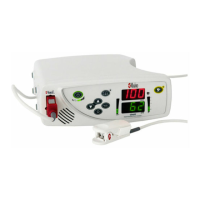4-6 Rad-8 Signal Extraction Pulse Oximeter Operator’s Manual
4
operation
ACTIONS TO BE TAKEN
If the SpO
2
readings show significant differences, do the following:
■ Make sure the emitter and detector are aligned directly opposite each other.
■ Select a site where the distance between the emitter and detector is minimized.
■ Wipe the sensor site with a 70% isopropyl alcohol pad or rubefacient cream
(10-30% methyl salicylate and 2-10% menthol) for 20-30 seconds. Strong
vasodilator creams, such as nitroglycerin paste, are not recommended.
■ If possible, remove electrical noise sources such as electro-surgical units or other
electrical/electronic equipment
■ If artificial nails or excessive fingernail polish are present, select another site or
remove the polish/artificial nails.
■ If possible, ensure that the sensor is placed in a location with low ambient light.
Although the pulse oximeter integrated with Masimo SET technology has significant
immunity to ambient light, excessive ambient light may cause readings to be incorrect.
CAUTION: IF ANY MEASUREMENT SEEMS QUESTIONABLE, FIRST CHECK THE
PATIENT’S VITAL SIGNS BY ALTERNATE MEANS AND THEN CHECK THE
PULSE OXIMETER FOR PROPER FUNCTIONING.
SIGNAL IQ - (SIQ)
The display provides a visual indicator of the plethysmogram signal quality and an alert
when the displayed SpO
2
values are not based on adequate signal quality. The signal
quality indicator displayed is called the Signal IQ. The Signal IQ can be used to identify the
occurrence of a patient’s pulse and the associated signal quality of the measurement.
The Signal IQ is shown as a “bouncing bar” indicator, where the peak of the bar coincides
with the peak of an arterial pulsation. Even with a plethysmographic waveform obscured by
artifact, the device locates the arterial pulsation. The pulse tone (when enabled) coincides
with the peak of the Signal IQ bar. As saturation increases or decreases, the pulse tone will
ascend or descend accordingly, for each 1% change in saturation.
The height of the Signal IQ bar indicates the quality of the measured signal. A high vertical
bar indicates that the SpO
2
measurement is based on a good quality signal. A small vertical
bar indicates that the SpO
2
measurement is based on data with low signal quality. When the
signal quality is very low the accuracy of the SpO
2
measurement may be compromised. A
“Low Signal IQ” is indicated by a bar height of two bars or less and the bars turn red. When
this occurs, proceed with caution and do the following:
■ Assess the patient.
■ Check the sensor and ensure proper sensor application. The sensor must be
well secured to the site to maintain accurate readings. Also, misalignment of the
sensor’s emitter and detector can result in smaller signals.
■ Determine if an extreme change in the patient’s physiology and blood flow at the
monitoring site occurred, (e.g. an inflated blood pressure cuff, a squeezing motion,
sampling of an arterial blood specimen from the hand containing the pulse oximetry
sensor, severe hypotension, peripheral vasoconstriction in response to hypothermia,
medications, or a spell of Raynaud’s syndrome.)
■ With neonates or infants, check that the peripheral blood flow to the sensor site is
not interrupted. Interruption, for example, as may occur while lifting or crossing their
legs, during a diaper change.
After performing the above, if the “Low Signal IQ” indication occurs frequently or continuously,
obtaining an arterial blood specimen for oximetry analysis may be considered to verify the
oxygen saturation value.

